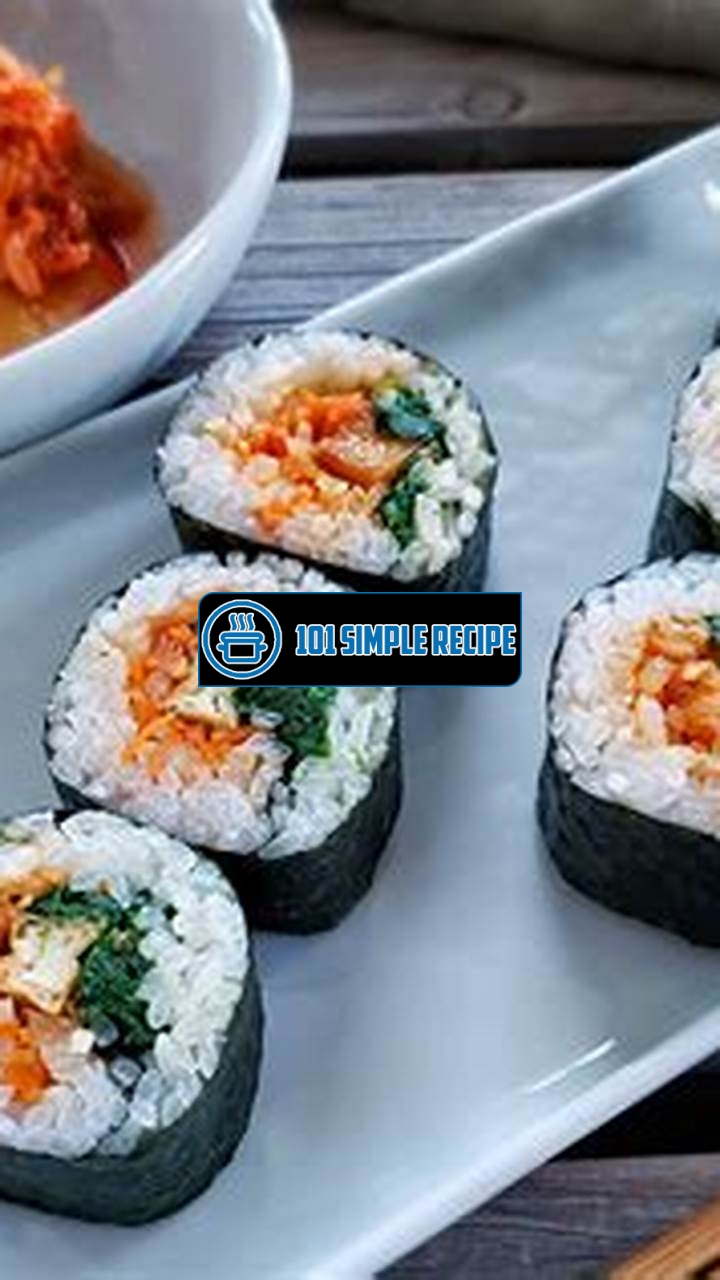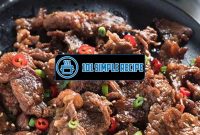Do you crave the flavors of Korean cuisine? If so, you’re in for a treat! Introducing the delicious Korean Seaweed Rice Roll recipe, a mouthwatering dish that brings together the vibrant flavors of seaweed, rice, and various fillings to create a delightful culinary experience. Whether you’re a seasoned foodie or simply looking to explore new flavors, this recipe is guaranteed to impress your taste buds. So, get ready to embark on a culinary journey as we guide you through the steps of creating this delectable dish that will leave you craving for more. But first, let’s take a visual tour of what awaits you:

Introduction to Korean Seaweed Rice Roll
Discover the origins and popularity of the Korean seaweed rice roll and why it has become a beloved dish around the world.
The History of Korean Seaweed Rice Roll
The Korean seaweed rice roll, also known as “gimbap” or “kimbap,” is a traditional Korean dish that dates back to the Joseon Dynasty. The origins of gimbap can be traced back to the Joseon royal court, where it was created as a portable meal for the king and the nobility. The dish was originally made with just rice and seaweed, then later filled with various ingredients such as fish, vegetables, and meat.
The popularity of gimbap spread throughout Korea, and eventually, it became a favorite street food snack. Today, it is loved by Koreans of all ages and has gained international recognition as a delicious and healthy dish.
Gimbap has gained popularity not only in Korea but also around the world. It is now commonly found in Korean restaurants and Asian food stalls worldwide. The dish’s simple yet flavorful combination of ingredients, along with its portability, makes it a go-to choice for a quick and satisfying meal.
Why Korean Seaweed Rice Roll is Loved Globally
One of the reasons why the Korean seaweed rice roll is loved globally is its versatility. The dish can be customized with a variety of fillings, making it suitable for different taste preferences and dietary restrictions. From traditional fillings like bulgogi (marinated beef), kimchi (spicy fermented cabbage), and pickled radish to modern variations like spicy tuna and avocado, gimbap offers a wide range of flavor combinations.
Another reason for its global popularity is its nutritional value. The Korean seaweed rice roll is a balanced meal in itself, providing a good source of carbohydrates from the rice, protein from the fillings, and vitamins and minerals from the vegetables. The inclusion of seaweed adds an extra nutritional boost, as it is rich in iodine, iron, and calcium.
️ Additionally, gimbap’s delicious taste and aesthetic appeal contribute to its worldwide acclaim. The combination of fresh ingredients, savory fillings, and the umami flavor of the seaweed creates a satisfying and visually appealing dish.
The Health Benefits of Korean Seaweed Rice Roll
The Korean seaweed rice roll offers several health benefits. Firstly, seaweed is an excellent source of antioxidants, which can help protect against cellular damage. It also contains dietary fiber, which aids in digestion and promotes a feeling of fullness.
The inclusion of vegetables in gimbap provides essential vitamins and minerals, such as vitamin A, vitamin C, and potassium. These nutrients support a healthy immune system and contribute to overall well-being.
If gimbap is filled with fish or seafood, it becomes a great source of omega-3 fatty acids, which have been linked to numerous health benefits, such as reducing inflammation and improving heart health.
✅ In conclusion, the Korean seaweed rice roll, or gimbap, has a rich history, global popularity, and impressive health benefits. Whether enjoyed as a quick snack, a light lunch, or a party appetizer, gimbap’s delicious flavors and nutritional value make it a beloved dish worldwide.
Choosing the Right Ingredients
In order to make a delicious Korean seaweed rice roll, it is important to select the right ingredients. Here, we will discuss the essential components needed for this recipe and where you can find them.
High-Quality Seaweed
To create a mouthwatering Korean seaweed rice roll, you must start with high-quality seaweed. Look for seaweed sheets that are fresh, vibrant green in color, and have a slightly glossy appearance. These characteristics indicate that the seaweed is of good quality and will enhance the flavor of your rice roll.
Important: When choosing seaweed, make sure it is specifically labeled for sushi or rice rolls. This will ensure that it is the right size and texture for your dish.
Perfectly Cooked Rice
The foundation of any Korean seaweed rice roll is the rice. It is crucial to cook the rice properly to achieve the perfect texture and taste. Use short-grain rice, also known as sushi rice, for the best results. Rinse the rice thoroughly before cooking to remove any excess starch.
Important: It is essential to cook the rice with the correct water-to-rice ratio. For every cup of rice, use 1.5 cups of water. Follow the cooking instructions on the rice package and ensure the rice is cooked until it is tender but still slightly firm.
After cooking, allow the rice to cool before using it for the seaweed rolls. This will prevent the rice from becoming too sticky and clumping together.
Filling Options for Korean Seaweed Rice Roll
Korean seaweed rice rolls can be filled with a variety of ingredients to add flavor and texture. Here are some popular options for fillings:
- Thinly sliced vegetables such as cucumber, carrot, and radish
- Protein options like cooked shrimp, crab sticks, or grilled beef
- Kimchi, a traditional Korean side dish made of fermented vegetables
- Avocado, which adds creaminess to the rolls
- Eggs, either scrambled or omelette-style
Note: Feel free to get creative and mix and match fillings according to your taste preferences. Experiment with different combinations to discover your favorite flavor combinations.
In summary, to create a delicious Korean seaweed rice roll, it is essential to choose high-quality seaweed, perfectly cooked rice, and fillings that complement each other. By selecting the right ingredients and following the proper techniques, you can enjoy a satisfying and flavorful Korean seaweed rice roll.
If you’re a fan of sweet treats, you’ll love this cookie in a mug recipe. It’s quick and easy to make, and it’s a great way to satisfy your sweet tooth.
Preparing the Seaweed and Rice
Discover the step-by-step process of preparing the seaweed and rice for the Korean seaweed rice roll, ensuring the perfect texture and taste.
Soaking and Trimming the Seaweed
To start making the delicious Korean seaweed rice roll, you need to soak and trim the seaweed properly. Soak the seaweed sheets in a bowl of cold water for about 10 minutes until they become soft and pliable. This step is crucial as it helps to remove any excess salt and soften the texture of the seaweed.
Note: Soaking the seaweed not only makes it easier to roll but also enhances its taste.
After soaking, gently pat the seaweed sheets dry with a paper towel and trim off any rough edges. This step ensures that the seaweed rolls neatly and gives the rice rolls a polished appearance.
Cooking and Seasoning the Rice
Now that the seaweed is ready, let’s move on to the rice preparation. Rinse 2 cups of short-grain Korean rice under cold water until the water runs clear. Then, add the rinsed rice to a rice cooker along with 2 ¼ cups of water. Cook the rice according to the rice cooker instructions.
Once the rice is cooked, transfer it to a large mixing bowl. While the rice is still hot, season it with a mixture of ⅓ cup rice vinegar, 2 tablespoons sugar, and 1 teaspoon salt. Stir the rice gently to evenly distribute the seasoning, ensuring every grain is coated.
Note: Seasoning the rice with vinegar, sugar, and salt gives it a delightful tangy-sweet taste that complements the seaweed perfectly.
Assembling the Seaweed Rice Roll
With the seaweed and rice prepared, it’s time to assemble the Korean seaweed rice roll. Lay one sheet of seaweed on a bamboo sushi mat or a clean kitchen towel. Spread a thin layer of seasoned rice evenly on the seaweed, leaving a small border at the top edge to seal the roll.
- Place your choice of fillings, such as thinly sliced vegetables, cooked meat or seafood, or pickled radish, in a neat line across the center of the rice.
- Gently lift the edge of the bamboo sushi mat or kitchen towel closest to you, and roll it over the fillings, pressing firmly but gently to ensure a tight roll.
- Continue rolling until the seaweed completely wraps around the fillings and forms a cylindrical shape. Use a little water on the border of the seaweed to seal the roll.
Note: Adding various fillings to the rice roll allows for a burst of flavors and textures in every bite.
Once the roll is sealed, use a sharp knife to slice it into bite-sized pieces. Serve the delicious Korean seaweed rice roll with soy sauce, wasabi, and pickled ginger for a complete and satisfying meal or snack.
Enjoy the taste of Korea with this simple and flavorful dish!
If you’re looking for a fun and refreshing drink to accompany your Korean seaweed rice roll, try this punch bowl recipe. It’s perfect for parties or gatherings.
Mastering the Rolling Techniques
When it comes to creating delicious Korean seaweed rice rolls, mastering the rolling techniques is essential. Whether you are a beginner or an experienced cook, learning different rolling techniques will not only help you create visually appealing rice rolls but also ensure that they are tightly rolled and hold their shape. In this article, we will explore the basic rolling technique, the inside-out rolling technique, and creative variations of these techniques to elevate your rice roll game.
Basic Rolling Technique
The basic rolling technique is the foundation for creating perfect Korean seaweed rice rolls. To start, lay a sheet of seaweed on a bamboo mat. Spread a thin layer of cooked sushi rice evenly over the seaweed, leaving a small border at the edge closest to you. Add your desired fillings, such as sliced cucumber, carrot, and cooked meat or seafood.
Now comes the rolling part. Use your fingertips to gently lift the edge of the bamboo mat closest to you, tucking it over the fillings. Apply slight pressure as you roll the mat away from you, creating a tight cylinder. The bamboo mat will help shape and tighten the roll.
Note: It is important to apply even pressure throughout the rolling process to ensure a compact and firm rice roll. This will prevent it from falling apart when sliced.
Inside-Out Rolling Technique
The inside-out rolling technique, also known as “uramaki,” involves placing the rice on the outside of the seaweed instead of the inside. This technique creates a visually stunning rice roll with the fillings showcased on the inside.
To execute the inside-out rolling technique, start by covering your bamboo mat with a sheet of plastic wrap. Place a sheet of seaweed on top of the plastic wrap and wet your hands slightly to prevent the rice from sticking. Spread a thin layer of sushi rice over the seaweed, covering it completely.
Carefully flip the seaweed and rice layer, so the rice is now facing down on the plastic wrap. Add your desired fillings in a line across the center. Again, use the bamboo mat to roll the rice and fillings into a tight cylinder. The plastic wrap will help keep the rice from sticking to the mat.
Note: Inside-out rice rolls often include garnishes like sesame seeds or flying fish roe on the outer layer of rice. Get creative with your ingredients to add both flavor and visual appeal.
Creative Variations of Rolling Techniques
To add flair to your Korean seaweed rice rolls, consider experimenting with creative variations of rolling techniques. Here are a few ideas to get you started:
- Slice and Arrange: Instead of rolling the rice and fillings, slice the seaweed and rice into rectangular pieces. Arrange the rice and fillings creatively on top of the seaweed, creating a beautiful presentation.
- Layered Roll: Create a layered effect by rolling multiple sheets of seaweed and rice together, alternating colors and fillings. The resulting roll will have striking patterns when sliced.
- Inside-Out Rainbow Roll: Use different colors of sushi rice, such as white, pink, yellow, and green, to create a vibrant and eye-catching inside-out roll.
- Tempura Roll: Add a twist to your rice rolls by incorporating crispy tempura inside. The combination of the crunchy tempura and the soft rice creates a delightful contrast of textures.
Note: Feel free to let your imagination run wild and create your own unique variations of rolling techniques. The key is to have fun and enjoy the process of making these delicious Korean seaweed rice rolls.
For a delicious and easy-to-make Korean seaweed rice roll recipe, check out this weight loss recipe. It’s a great option for a healthy and satisfying meal.
Additional Tips for the Perfect Korean Seaweed Rice Roll
Discover expert tips and tricks to enhance the flavor and presentation of your Korean seaweed rice roll.
Enhancing the Flavor with Sauce and Seasonings
When it comes to making the perfect Korean seaweed rice roll, the right sauce and seasonings can take it to the next level. Consider these tips to enhance the flavor of your roll:
- Use a flavorful sauce: A delicious sauce can bring out the flavors of the ingredients in your rice roll. Consider using gochujang, a spicy Korean red pepper paste, mixed with soy sauce, sesame oil, and a touch of honey for a perfect balance of sweet and spicy.
- Experiment with seasonings: Don’t be afraid to get creative with your seasonings. Add some garlic powder, ginger, or even a pinch of curry powder to give your rice roll a unique and tasty twist.
- Marinate your ingredients: To infuse even more flavor into your rice roll, marinate your ingredients before assembling them. A simple marinade of soy sauce, sesame oil, and a splash of rice vinegar can do wonders for the taste.
Garnishing and Presentation Ideas
When it comes to presentation, a beautifully garnished Korean seaweed rice roll can be a feast for the eyes as well as the taste buds. Consider these ideas to make your roll visually appealing:
- Add a pop of color: Use brightly colored vegetables like bell peppers, carrots, or cucumbers to add a vibrant touch to your rice roll.
- Create decorative patterns: Use a sharp knife to create intricate patterns on the surface of the roll. It not only looks impressive but also adds a unique texture to each bite.
- Garnish with herbs: Sprinkle some fresh cilantro or thinly sliced green onions on top of your rice roll for a refreshing burst of flavor and a touch of green.
Storing and Serving Your Korean Seaweed Rice Roll
Proper storage and serving techniques can ensure that your Korean seaweed rice roll stays fresh and delicious. Here are some tips:
- Keep it fresh: To maintain the freshness of your rice roll, wrap it tightly with plastic wrap or store it in an airtight container in the refrigerator. This will prevent the rice from drying out.
- Serve with dipping sauce: Korean seaweed rice rolls are traditionally served with a dipping sauce. Prepare a small bowl of soy sauce mixed with a splash of rice vinegar and some sesame seeds for a tangy and flavorful accompaniment.
- Slice it right: When it’s time to serve your rice roll, use a sharp knife to cut it into bite-sized pieces. This will make it easier to eat and also showcase the beautiful layers of ingredients inside.
Remember, the key to a delicious Korean seaweed rice roll lies in the sauce, garnishes, and proper storage and serving. Be creative and have fun experimenting with different flavors and presentation styles to make your rice roll truly outstanding.
Happy rolling!
Thank you for taking the time to read our article about Korean seaweed rice rolls! We hope that you found the information and recipe inspiring. Whether you’re a beginner or a seasoned cook, this dish is a must-try for anyone who enjoys the flavors of Korean cuisine. If you’re craving a healthy and delicious meal, remember to bookmark our page and come back to visit us for more recipes and cooking tips. Happy cooking!
Frequently Asked Questions
Here are some common questions about Korean seaweed rice rolls:
| No. | Questions | Answers |
|---|---|---|
| 1. | Can I use different types of rice for this recipe? | Yes, you can use different types of rice, such as brown rice or black rice, to add variety and nutritional value to your seaweed rice rolls. |
| 2. | Can I replace the seaweed with lettuce? | While lettuce can be used as a substitute, the unique flavor and texture of seaweed add an essential element to the dish. We recommend using seaweed for an authentic taste. |
| 3. | Are there vegetarian options for the filling? | Absolutely! You can use various vegetarian fillings, such as tofu, mushrooms, or pickled vegetables, to suit your dietary preferences. |
| 4. | Can I make these rice rolls ahead of time? | Yes, you can prepare the rice rolls in advance and store them in the refrigerator. Just make sure to wrap them tightly in plastic wrap to prevent them from drying out. |
| 5. | What dipping sauce goes well with Korean seaweed rice rolls? | A popular dipping sauce for these rice rolls is a mixture of soy sauce, sesame oil, rice vinegar, and a touch of sugar. It adds a tangy and savory flavor to complement the rolls. |
| 6. | Can I add additional ingredients to the filling? | Absolutely! Feel free to experiment and add your favorite ingredients, such as avocado, cucumber, or shrimp, to make the rice rolls even more delightful. |
Closing Thoughts
We hope you enjoyed learning about Korean seaweed rice rolls as much as we enjoyed sharing this recipe with you. These rolls are not only delicious but also a fun way to explore Korean cuisine. Remember to get creative with your fillings and dipping sauces to personalize your rolls. If you’re looking for more culinary inspiration, make sure to visit us again soon. Until then, happy cooking and enjoy your homemade Korean seaweed rice rolls!
Jump to Recipe
Korean Seaweed Rice Roll

Learn how to make delicious Korean seaweed rice rolls filled with fresh ingredients. Perfect for a healthy and flavorful snack or meal.
- 4 sheets of roasted seaweed
- 2 cups cooked short-grain white rice
- 1 carrot (julienned)
- 1 cucumber (julienned)
- 4 ounces cooked crab meat
- 2 tablespoons soy sauce
- 1 tablespoon rice vinegar
- 1 tablespoon sesame oil
- 1 teaspoon sugar
- In a bowl, combine the cooked rice, carrot, cucumber, and crab meat.
- Place a sheet of roasted seaweed on a bamboo mat. Spread about 1/2 cup of the rice filling evenly on the seaweed, leaving a small border at the top. Roll the seaweed tightly using the bamboo mat, pressing gently to seal.
- In a small bowl, whisk together the soy sauce, rice vinegar, sesame oil, and sugar until well combined.
- Slice the rolled seaweed into bite-sized pieces and serve with the dipping sauce. Enjoy your delicious Korean seaweed rice rolls!






